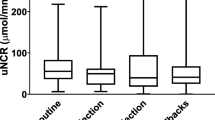Abstract
Background
The objective of this study was to examine whether there was an association between acute rejection (AR) and nitric oxide (NO) levels and also to evaluate the clinical impact of NO measurement as a noninvasive marker for early detection of AR.
Methods
Fifty consecutive patients aged 17–62 years old received a living-related kidney graft. Serum levels of total nitrite and nitrate (NOx) were measured 30 min after graft reperfusion (NOx 1) and on days 1 (NOx 2), 5 (NOx 3), and 10 (NOx 4) post-transplantation (Tx). If clinically indicated, graft biopsy was performed.
Results
Acute humoral rejection was diagnosed by biopsy on 3rd post-Tx day in one patient. His serum NOx 2 levels were remarkably higher (380%) compared with his NOx 1 measurement. At the same time, NOx 1–2 measurements in uncomplicated group showed lower levels (−12%). Additionally, during the first month post-Tx, 5 cases of acute cellular rejection (ACR) were diagnosed. The mean percent change of NOx 3–4 levels in ACR group was 180.7 versus 16.1 in uncomplicated patients (P < 0.01). In addition, >70 μmol/L change in NOx levels in consecutive samples had a sensitivity of 100% and a specificity of 97.7% in predicting AR episodes.
Conclusion
Our study reports significant increase in serum NOx levels in episodes of AR. NOx might be an useful noninvasive marker for early diagnosis of AR.



Similar content being viewed by others
References
Gjertson DW (2000) Impact of delayed graft function and acute rejection on kidney graft survival. Clin Transpl: 467–80
Pallardó Mateu LM, Sancho Calabuig A, Capdevila Plaza L, Franco Esteve A (2004) Acute rejection and late renal transplant failure: risk factors and prognosis. Nephrol Dial Transpl 19(Suppl 3):iii38–iii42
Shin GT, Kim SJ, Lee TS, Oh CK, Kim H (2005) Gene expression of perforin by peripheral blood lymphocytes as a marker of acute rejection. Nephron Clin Pract 100:c63–c70
Erickson LM, Pan F, Ebbs A, Kobayashi M, Jiang H (2003) Microarray-based gene expression profiles of allograft rejection and immunosuppression in the rat heart transplantation model. Transplantation 76:582–588
Kurian SM, Heilman R, Mondala TS et al (2009) Biomarkers for early and late stage chronic allograft nephropathy by proteogenomic profiling of peripheral blood. PLoS One 4(7):e6212
Reeve J, Einecke G, Mengel M et al (2009) Diagnosing rejection in renal transplants: a comparison of molecular- and histopathology-based approaches. Am J Transpl 9(8):1802–1810
Gross SS, Wolin MS (1995) Nitric oxide: pathophysiological mechanisms. Annu Rev Physiol 57:737–769
Kuo PC, Alfrey EJ, Abe KY, Huie P, Sibley RK, Dafoe DC (1996) Cellular localization and effect of nitric oxide synthesis in a rat model of orthotopic liver transplantation. Transplantation 61:305–312
Stoica SC, Satchithananda DK, Atkinson C, Charman S, Goddard M, Large SR (2003) Heat shock protein, inducible nitric oxide synthase and apoptotic markers in the acute phase of human cardiac transplantation. Eur J Cardiothorac Surg 24(6):932–939
Stevens RB, Ansite JD, Mills CD et al (1996) Nitric oxide mediates early dysfunction of rat and mouse islets after transplantation. Transplantation 61:1740–1749
Dedeoglu IO, Feld LG (1996) Decreased urinary excretion of nitric oxide in acute rejection episodes in pediatric renal allograft recipients. Transplantation 62:1936–1938
Albrecht EW, van Goor H, Tiebosch AT, Moshage H, Tegzess AM, Stegeman CA (2000) Nitric oxide production and nitric oxide synthase expression in acute human renal allograft rejection. Transplantation 70:1610–1616
Khanafer A, Ilham MA, Namagondlu GS et al (2007) Increased nitric oxide production during acute rejection in kidney transplantation: a useful marker to aid in the diagnosis of rejection. Transplantation 84:580–586
Mattson DL, Wu F (2000) Nitric oxide synthase activity and isoforms in rat renal vasculature. Hypertension 35:337–341
Saura M, López S, Rodríguez Puyol M, Rodríguez Puyol D, Lamas S (1995) Regulation of inducible nitric oxide synthase expression in rat mesangial cells and isolated glomeruli. Kidney Int 47(2):500–509
Chatterjee PK, Hawksworth GM, McLay JS (1999) Cytokine-stimulated nitric oxide production in the human renal proximal tubule and its modulation by natriuretic peptides: a novel immunomodulatory mechanism? Exp Nephrol 7(5–6):438–448
Joles JA, Vos IH, Gröne HJ, Rabelink TJ (2002) Inducible nitric oxide synthase in renal transplantation. Kidney Int 61:872–875
Green LC, Ruiz de Luzuriaga K, Wagner DA et al (1981) Nitrate biosynthesis in man. Proc Natl Acad Sci USA 78:7764–7768
Tsikas D (2005) Methods of quantitative analysis of the nitric oxide metabolites nitrite and nitrate in human biological fluids. Free Radic Res 39(8):797–815
Solez K, Colvin RB, Racusen LC et al (2008) Banff 07 classification of renal allograft pathology: updates and future directions. Am J Transpl 8:753–760
Shoskes DA, Xie Y, Gonzalez-Cadavid NF (1997) Nitric oxide synthase activity in renal ischemia-reperfusion injury in the rat: implications for renal transplantation. Transplantation 63:495–500
Castillo J, Berrazueta JR, Herrera L et al (1996) Nitric oxide production during the hyperacute vascular rejection. J Surg Res 63:375–380
Tullius SG, Nieminen M, Bechstein WO et al (1998) Prompt treatment of initial acute rejection episodes may improve long-term graft outcome. Transpl Int 11:S3–S4
Bellos JK, Perrea DN, Vlachakos D, Kostakis AI (2005) Chronic allograft nephropathy: the major problem in long-term survival: review of etiology and interpretation. Transpl Rev (Orlando) 19:138–144
Hirt SW, You XM, Möller F et al (1998) Early treatment of acute rejection prevents chronic rejection in a rat model of allogenic left lung transplantation. Transpl Proc 30:1005–1006
Acknowledgments
This study was supported by a grant for scientific research from “Empeirikeion” Foundation.
Author information
Authors and Affiliations
Corresponding author
Rights and permissions
About this article
Cite this article
Bellos, J.K., Perrea, D.N., Theodoropoulou, E. et al. Clinical correlation of nitric oxide levels with acute rejection in renal transplantation. Int Urol Nephrol 43, 883–890 (2011). https://doi.org/10.1007/s11255-010-9858-9
Received:
Accepted:
Published:
Issue Date:
DOI: https://doi.org/10.1007/s11255-010-9858-9




